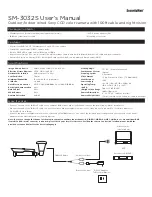
11
Mounting and Connection Instructions Viewguard PIR RF
9.
Radio revision mode
The radio revision mode is used, prior to the actual installation, to
determine a mounting site suitable for transmission and reception. To
run the radio revision mode, you will need an RF BUS-2 wireless
receiver.
Please observe the information in the Mounting and
Connection Instructions of the associated RF BUS-2
wireless receiver.
- Detector must be in the de-energised state, battery connecting plug
must be pulled.
- Press radio revision mode button and hold it down (Fig. 2- ).
- Plug in the battery connecting plug and then release the radio revi-
sion mode button.
- The radio revision mode is automatically left after 15 minutes.
- The radio revision mode can be left by pulling off the battery and
plugging it in again.
To connect a hazard detection system, you will need the RF BUS-2
wireless receiver (Item no. 015600 or 015600.01). The detector will
be detected as radio detector when it is connected for the first time
and during the programming of the RF BUS-2 wireless receiver.
Control panel
from V09.xx (HB/MB24, HB/MB48, MB100)
(HB48 and MB100 with Index .10)
WINFEM Advanced
from V07.xx
The following parameters can be programmed from the control panel
via the BUS-2 system and the RF BUS-2 wireless receiver:
Area mirror 8 / 11 / 13 / 15 m
Long-range mirror 29 / 35 / 42 / 50 m
Curtain mirror 17 / 21 / 25 / 30 m
normal / high
Sensitivity "high" not as per VdS
- for area mirror with range 15 m
- for long-range mirror with range 50 m
- for curtain mirror with range 30 m
threshold, tol/-2 °C
Allowable range: -10 °C to +55 °C
9.1
Switching on the radio revision mode
9.2
LED displays in radio revision mode
9.3
Switching off the radio revision mode
2
Unable to establish communication with the RF BUS-2 wire-
less receiver.
No communication possible.
Communication with the RF BUS-2 wireless receiver can be
established, but the (transmitter/receiver) distance is too large
or the field strength required for a reliable communication is
too low.
Communication with the RF BUS-2 wireless receiver can be
established using the required field strength.
The red LED is lit:
The red and yellow LEDs are lit:
The yellow LED is lit:
10. Programming
Programming information
Required software:
- Range
- Sensitivity
- Temp. alarm
By operating as per VdS observe:
11. Start-up
11.1
Check installation
11.2
Insert battery and close housing
11.3
Walk test
11.4
Insert seal
To ensure reliable functioning, all system parts must be installed
correctly.
Nach dem Einbauen der Batterie und Anstecken des Batteriean-
schluss-Steckers führt der Melder eine Initialisierung durch. Die beiden
LEDs blinken (siehe 12.1.4). Nach spätestens 60 Sekunden ist der
Melder betriebsbereit.
(see installation instructions of
the control panel). The walk test can be switched on and off directly via
the control panel.
The PIR detector recognizes movements in response to the temperatu-
re difference between a person and the background of the room.
Observe while performing a walk test: There would be different ranges
for the monitored area / detection coverage depending on environment
conditions. The walk test should be done under realistic conditions, at
this the clothes of the person and the room temperature do mostly
influence the accurateness of the detection.
To have some
even under extremely unfavourable conditions,
the detector should be set to a higher detection range or
should be installed.
(siehe Abb. 1- ).
Ensure that the housing is closed correctly.
Insert the seal. The housing is now locked and can only be opened by
removing the seal.
Perform a walk test for every detector
Check the monitored area of the detector.
reserve
a second PIR
detector
5
12. Operation
12.1
LED indication
12.1.1 After disarming
12.1.3 Operating state
“
armed
”
and
“
disarmed
”
12.1.4 Special casel initial start up
Note: A detected alarm remains stored in the detector until it
is cleared.
This detector was the first to trigger an alarm.
All subsequent detectors.
detected
This signifies that a
has occurred
The LED indication is blanked.
After applying the operating voltage (battery) only in the case
of initial start up.
The red LED flashes quick:
The red LED flashes slowly:
The red LED flashes slowly:
The yellow LED flashes slowly:
The red and yellow LEDs are flashing quick (in the intervall)
First alarm
Subsequent alarm
Movement
battery fault
12.1.2 Operating state "walk test"
(low battery
voltage) vor.
:






























